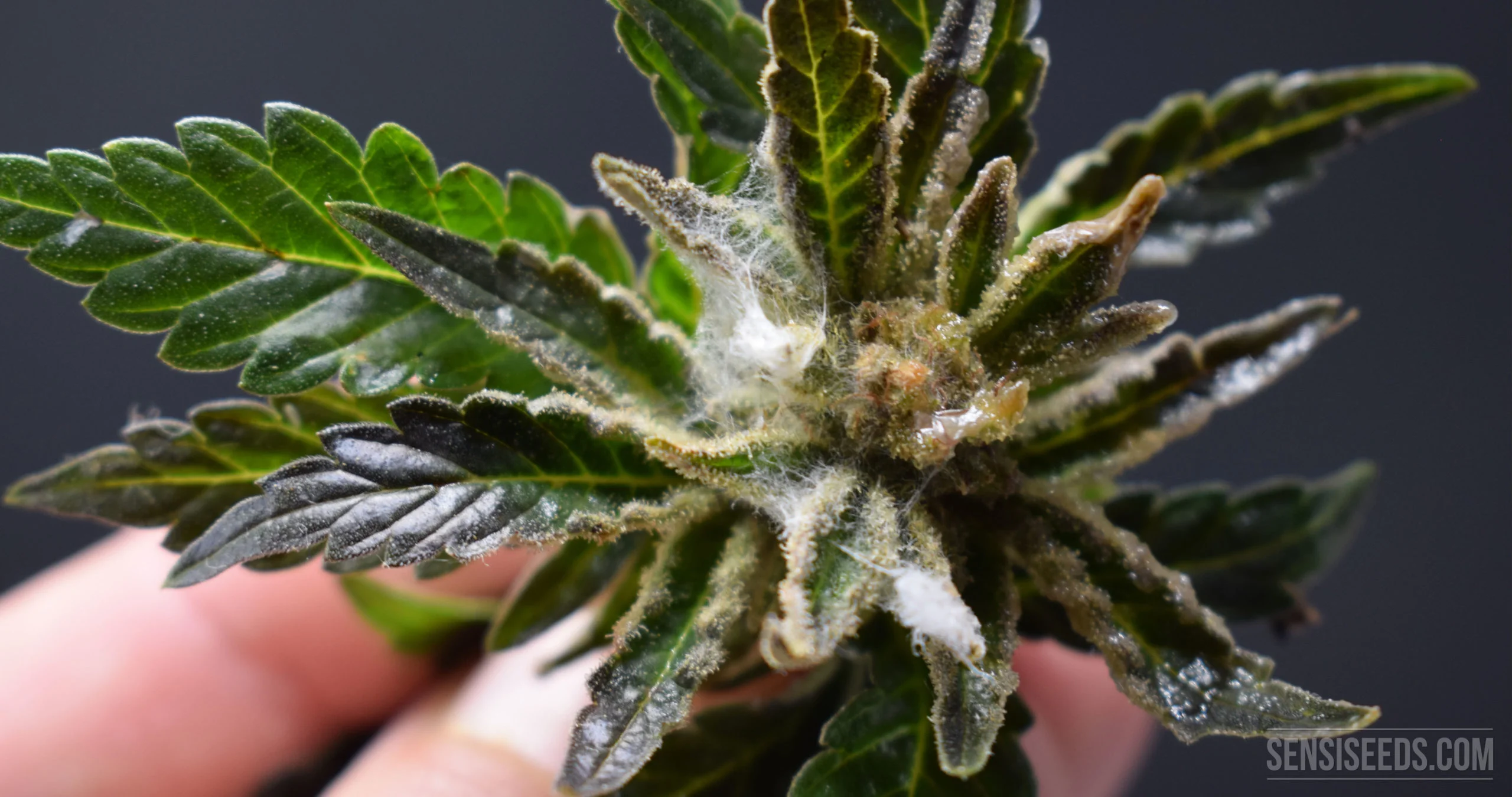
Cannabis cultivation demands a keen eye for detail and a deep understanding of plant health, especially when it comes to identifying and managing potential threats like bud rot. Bud rot, scientifically known as Botrytis cinerea, is a fungal disease that can wreak havoc on cannabis plants if left unchecked. This pervasive issue not only affects the quality and yield of your harvest but also poses serious risks to the overall health of your cultivation environment.
Ignoring or misidentifying bud rot can lead to devastating consequences for growers. Infected buds not only lose their potency and flavour but can also become a breeding ground for mold and other pathogens. As the rot spreads, it can compromise neighbouring plants, rapidly escalating the problem and jeopardizing an entire crop. Moreover, the presence of mold and rot in harvested cannabis can pose health risks to consumers, making it crucial for growers to be proactive in identifying and addressing bud rot at the earliest stage possible.
In the Canadian cannabis market, where quality and safety are paramount, understanding and effectively managing bud rot is essential for both novice and experienced growers. By arming yourself with knowledge and taking preventive measures, you can safeguard your cannabis plants, ensuring a healthy and bountiful harvest while maintaining the integrity of your cultivation practices.
Bud rot, formally known as Botrytis cinerea, is a fungal disease that specifically targets cannabis plants during their growth cycle. This pathogen thrives in moist and humid conditions, making it particularly problematic for growers in environments where controlling humidity levels is challenging. Botrytis cinerea attacks the buds of cannabis plants, leading to a rapid deterioration of their quality and structure.
When bud rot infects cannabis plants, it begins by infiltrating the buds, initially manifesting as small, water-soaked lesions. As the disease progresses, these lesions expand and become brown or grayish in colour, eventually turning the affected buds into a mushy consistency. Alongside the visible decay, white or gray mold may also develop on the surface of the buds, further confirming the presence of bud rot.
The impact of bud rot on cannabis plants goes beyond mere cosmetic damage. As the disease advances, it compromises the plant’s ability to absorb nutrients and water, hindering its growth and development. Infected buds also lose their potency, flavour, and aroma, significantly diminishing the quality of the final product. In severe cases, bud rot can spread rapidly throughout the plant, leading to the wilting and death of entire branches or even the entire plant itself.
Understanding the nature and effects of bud rot is crucial for cannabis growers, as early detection and intervention are key to minimizing its impact. By familiarizing themselves with the signs and symptoms of bud rot, growers can take proactive measures to protect their plants and preserve the quality of their harvest.
Bud rot, although primarily a result of the Botrytis cinerea fungus, is often exacerbated by a combination of environmental factors and plant stressors that create ideal conditions for its growth and spread. Understanding these underlying causes is pivotal for cannabis growers looking to mitigate the risk of bud rot in their cultivation operations.
One of the primary environmental factors that contribute to bud rot is humidity. High levels of humidity create a moist environment that is conducive to fungal growth, making cannabis plants more susceptible to infection. Similarly, temperature plays a crucial role, with cooler temperatures combined with high humidity being particularly favourable for the development of Botrytis cinerea. Poor air circulation further exacerbates these conditions by allowing moisture to accumulate around the buds, creating an environment where the fungus can thrive.

In addition to environmental factors, certain plant stressors can also increase the susceptibility of cannabis plants to bud rot. Nutrient deficiencies, for instance, weaken the plant’s immune system, making it less capable of resisting fungal infections. Overwatering is another common mistake that can lead to bud rot, as it creates waterlogged conditions that promote fungal growth while depriving the roots of oxygen. Pest infestations, such as spider mites or aphids, can also stress cannabis plants and create entry points for fungal pathogens, further increasing the risk of bud rot.
For Canadian cannabis growers, managing these causes of bud rot requires a multifaceted approach that includes optimizing environmental conditions, ensuring proper nutrient balance, and maintaining vigilant pest control measures. By addressing these underlying causes proactively, growers can significantly reduce the risk of bud rot and protect the health and vitality of their cannabis plants.
Identifying bud rot in its early stages is crucial for effective management and prevention of its spread. Recognizing the signs and symptoms of bud rot allows growers to take immediate action, potentially saving their crop from extensive damage.
Visually, buds affected by bud rot undergo noticeable changes in appearance. Initially, the affected areas may appear as small, water-soaked lesions that gradually darken to a brown or grayish hue. As the disease progresses, these areas become increasingly mushy and may disintegrate upon touch. Alongside the decay of the buds, growers may also observe the growth of white or gray mold on the surface, which further confirms the presence of bud rot. This mold can sometimes be mistaken for trichomes or other benign substances, so it’s crucial to differentiate between them for accurate diagnosis.
Texture changes are another hallmark of bud rot. Infected buds lose their firmness and develop a soft, spongy consistency due to the decay caused by the fungus. This change in texture is often one of the first indicators that a bud is affected by bud rot, as healthy buds should feel firm to the touch.
One of the less obvious but equally telling signs of bud rot is the odour emanating from the affected buds. As the fungus continues to spread and the buds decay, they emit a musty or moldy smell that is distinctively unpleasant. This odour can sometimes be detected even before visual signs of bud rot become apparent, serving as an early warning sign for growers to inspect their plants more closely.
For Canadian cannabis growers, being able to recognize these signs and symptoms of bud rot is essential for maintaining the health and quality of their crops. Regular monitoring and thorough inspection of plants can help catch bud rot in its early stages, allowing for timely intervention and minimizing the potential damage to the harvest.
In the world of cannabis cultivation, bud rot is just one of several challenges that growers may encounter. Differentiating bud rot from other common cannabis problems is essential for effective treatment and prevention strategies. Two issues that can easily be mistaken for bud rot are nutrient burn and powdery mildew, each with its own distinct characteristics and treatment approaches.
Nutrient burn often presents as the browning or yellowing of the tips of cannabis leaves, accompanied by a crispy or burnt appearance. While bud rot affects the buds directly, nutrient burn primarily impacts the foliage. Growers may sometimes confuse the browning buds of nutrient burn with the discolouration caused by bud rot. However, unlike bud rot, nutrient burn does not typically result in the mushy texture or mold growth associated with fungal infections.

On the other hand, powdery mildew is a fungal disease that, like bud rot, affects the buds and leaves of cannabis plants. However, powdery mildew manifests as a white, powdery substance on the surface of the leaves and buds, rather than the brown, mushy lesions characteristic of bud rot. While both conditions are caused by fungi, powdery mildew is easier to treat and less destructive than bud rot if caught early.
To accurately diagnose bud rot and differentiate it from other issues, growers should pay close attention to the specific symptoms exhibited by their plants. For bud rot, the presence of brown, mushy buds with white or gray mold growth, along with a musty odour, are key indicators. Nutrient burn, on the other hand, affects the leaves more than the buds and lacks the mushy texture and mold growth associated with bud rot. Powdery mildew presents with a distinctive white, powdery coating on the leaves and buds, without the decay and mold growth seen in bud rot.
Regular monitoring, careful observation, and familiarity with these symptoms are crucial for accurate diagnosis. By understanding the unique characteristics of each issue and paying attention to the specific signs exhibited by their plants, Canadian cannabis growers can avoid misidentifying bud rot and implement targeted treatment and prevention strategies more effectively.
Prevention is often the most effective strategy when it comes to managing bud rot in cannabis cultivation. By implementing proper cultivation practices and proactive measures, Canadian growers can significantly reduce the risk of bud rot and safeguard their crops against this pervasive fungal disease.
Optimal humidity and temperature control play a pivotal role in preventing bud rot. Maintaining humidity levels between 40% to 50% during the flowering stage can help create an environment less conducive to fungal growth. Similarly, ensuring a consistent temperature range between 20°C to 25°C can further deter the development and spread of Botrytis cinerea. Investing in quality humidity and temperature monitoring equipment can assist growers in maintaining these optimal conditions throughout the cultivation process.
Good air circulation is another crucial factor in bud rot prevention. Proper ventilation helps to reduce humidity levels, prevents moisture buildup around the buds, and promotes a healthier overall environment for cannabis plants. Growers can achieve this by strategically placing fans or implementing ventilation systems in their grow spaces to ensure adequate airflow around the plants.

Regular monitoring and inspection of plants are essential for early detection of bud rot and other potential issues. By routinely checking their plants for signs of infection, growers can identify and address bud rot at its earliest stages, minimizing its impact on the crop. This proactive approach also allows growers to implement timely interventions and adjust cultivation practices as needed to maintain plant health and vitality.
Sanitation measures play a crucial role in preventing the spread of bud rot. Cleaning and sterilizing gardening tools between uses can help prevent cross-contamination and reduce the risk of introducing fungal spores to healthy plants. Removing dead plant matter from the growing area also eliminates potential breeding grounds for fungi and pests, further reducing the risk of bud rot.
Lastly, strain selection can influence a plant’s resistance to bud rot. Some cannabis strains have been bred to be more resilient against fungal infections, making them a preferred choice for growers looking to mitigate the risk of bud rot. By selecting strains known for their resistance to Botrytis cinerea, growers can add an additional layer of protection to their cultivation efforts.
Preventing bud rot requires a comprehensive approach that encompasses proper cultivation practices, regular monitoring, sanitation measures, and informed strain selection. By adopting these preventive measures, Canadian cannabis growers can create a healthier and more resilient cultivation environment, reducing the risk of bud rot and ensuring the success of their crops.
While prevention is the cornerstone of managing bud rot, early detection and prompt treatment are equally crucial for minimizing its impact and preventing further spread within the cannabis crop. Once bud rot is identified, growers have several treatment options at their disposal to combat the fungal infection and salvage as much of their harvest as possible.
Early detection is key to effective treatment of bud rot. As soon as signs of bud rot are observed, such as brown, mushy buds with mold growth and a musty odour, growers should immediately remove the affected buds. This helps prevent the spread of the fungus to healthy parts of the plant and neighbouring plants, reducing the overall impact of the infection. Care should be taken to remove the infected buds carefully to avoid spreading spores, using sterilized tools and disposing of the infected material properly.
Natural remedies can be effective alternatives for treating bud rot, especially for growers who prefer to avoid chemical treatments. Neem oil, derived from the seeds of the neem tree, is known for its antifungal properties and can be applied to affected plants to combat Botrytis cinerea. Similarly, hydrogen peroxide can be diluted and sprayed on the infected buds to kill the fungus and prevent its spread. These natural remedies offer growers a more organic approach to treating bud rot while minimizing potential harm to the plants and the environment.
For growers looking for more aggressive treatment options, chemical treatments in the form of fungicides approved for cannabis cultivation can be effective against bud rot. These fungicides are specifically formulated to target fungal pathogens like Botrytis cinerea and can be applied as a spray or drench to treat infected plants. It’s crucial to choose a fungicide that is approved for use on cannabis and to follow the manufacturer’s instructions carefully to ensure safe and effective application. Additionally, growers should be mindful of any potential residues left by chemical treatments, especially if the cannabis is intended for consumption, and adhere to any applicable regulations or waiting periods before harvest.
Treating bud rot requires a combination of early detection, prompt action, and effective treatment methods. Whether opting for natural remedies or chemical treatments, the goal is to eliminate the fungus, prevent its spread, and protect the remaining healthy buds and plants. By being proactive and informed about the available treatment options, Canadian cannabis growers can effectively manage bud rot and safeguard their crops against this common fungal disease.
Harvesting cannabis plants affected by bud rot requires careful handling to minimize the risk of spreading the fungal infection and to ensure the safety and quality of the harvested buds. When harvesting affected plants, growers should take specific precautions to mitigate the spread of bud rot and salvage as much of the crop as possible.
Firstly, it’s essential to inspect the plants thoroughly before harvesting to identify and remove any buds showing signs of bud rot. As previously mentioned, early detection and removal of infected buds are crucial to prevent the spread of the fungus to healthy parts of the plant and neighbouring plants. Once the infected buds are removed, growers should sanitize their tools and hands to avoid spreading spores to other plants or surfaces.
When harvesting affected plants, it’s advisable to handle the buds gently to avoid further damage and decay. Carefully cut the buds from the plant, leaving some stem attached for easier handling and hanging during the drying process. After harvesting, separate the buds from different plants or sections to prevent cross-contamination, especially if not all plants were affected by bud rot.
After harvesting, proper storage is essential to prevent mold and bud rot post-harvest. Storing cannabis in a cool, dark, and dry environment helps maintain its freshness and potency while reducing the risk of fungal growth. Ensure that the storage area has good airflow to prevent moisture buildup, which can create conditions conducive to mold and bud rot.
Using airtight containers, such as glass jars with rubber seals, can help maintain optimal humidity levels and protect the buds from exposure to external contaminants. However, it’s crucial to avoid sealing the buds while they are still moist to prevent the growth of mold. Allow the buds to dry properly before storing them in airtight containers, opening the jars regularly to release any excess moisture and check for signs of mold.
Additionally, monitoring the stored cannabis regularly for any signs of mold or bud rot is essential. Inspect the buds for discolouration, unusual odours, or any other signs of fungal growth. If mold or bud rot is detected during storage, remove the affected buds immediately to prevent further contamination and ensure the safety of the remaining stash.
Harvesting and storing cannabis affected by bud rot require extra care and attention to detail to protect the quality and safety of the final product. By taking precautions during harvesting, implementing proper storage practices, and regularly monitoring the stored cannabis, Canadian growers can minimize the risk of mold and bud rot post-harvest and enjoy a safer and more enjoyable cannabis experience.
In the intricate world of cannabis cultivation, bud rot stands out as a significant challenge that requires diligence, knowledge, and proactive measures to manage effectively. The importance of early detection and prompt action cannot be overstated when it comes to identifying and managing bud rot. By recognizing the signs and symptoms early on, growers can minimize the impact of this fungal disease, protect their crops, and maintain the quality and potency of their harvest.
The journey from seed to harvest is filled with potential pitfalls, and bud rot is just one of the many obstacles that Canadian cannabis growers may encounter. However, with proper education, preventive strategies, and timely interventions, growers can navigate these challenges successfully and cultivate healthy, thriving plants.
Staying vigilant is crucial in the ongoing battle against bud rot and other potential threats to cannabis cultivation. Regular monitoring, thorough inspections, and a keen eye for detail are essential tools in a grower’s arsenal. By prioritizing plant health and implementing the best practices outlined in this article, growers can create a resilient cultivation environment that is less susceptible to bud rot and other fungal infections.
In closing, while bud rot may seem daunting, especially for those new to cannabis cultivation, it is a manageable issue with the right approach and resources. With a commitment to learning, adapting, and prioritizing plant health, Canadian cannabis growers can overcome the challenges posed by bud rot and continue to produce high-quality, safe, and enjoyable cannabis for themselves and others to enjoy. So, to all the dedicated growers out there, stay vigilant, keep learning, and may your harvests be bountiful and free from bud rot!
Order weed online in Winnipeg. Puff Wow makes it easy to buy Cannabis online with our secure checkout and fast delivery.
Winnipeg, Manitoba
Canada

